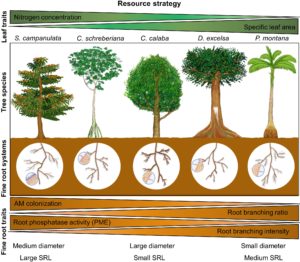Trade-offs in fine-root traits of common tree species in Puerto Rico’s tropical forests
The Science
This study measured root traits from five tropical tree species. We used a combination of traits related to soil phosphorus acquisition. We also measured these traits before and after two hurricanes in Puerto Rico. We found that architectural traits were oppositely adjusted to phosphatase activity and fungal colonization. These strategies were grouped by pioneer trees and non-pioneer trees. This study showed no change in root trait adjustments after the hurricanes, except for phosphatase activity.
The Impact
How plants adjust their root traits to better obtain nutrients is relevant for understanding their distribution. Understanding these adjustments under climatic disturbance can help us predict future scenarios. Although there are general gradients for some of these trait adjustments, most traits are not represented. Tropical plants have been less studied than temperate plants. This study highlights the negative relationships between architectural and physiological traits. Non-pioneer trees relied more on architectural traits than pioneer trees. Additionally, the unchanged adjustments of most root traits after the hurricanes shows the stability of the traits. Our results can help better understand root adjustments of some tropical trees under soils with low phosphorus availability.
Summary
Tropical trees might adjust their traits to better obtain soil phosphorus. For example, they can adjust their root length or root branching. They can also adjust their colonization by fungi or phosphatase activity. It is still not clear which combination of adjustments tropical trees might have to obtain soil phosphorus. Here, we measured seven root traits of five common trees in Puerto Rico. We described these trait adjustments and followed their changes after two hurricanes. We found that roots with high colonization of fungi and high phosphatase activity presented less branching. This strategy was mostly shown in pioneer trees. The opposite happened in non-pioneers. We also found that root traits adjustments did not change before and after the hurricanes, except for root phosphatase activity. Our results showed a combination of root trait adjustments for better obtain soil phosphorus in tropical trees and the stability on most of the root traits adjustment after hurricane disturbances.

Contact
Daniela Yaffar, Functional Forest Ecology, University of Hamburg, danielayaffar@uni-hamburg.de
Funding
This research was supported as part of the Next Generation Ecosystem Experiments‐Tropics, funded by the U.S. Department of Energy, Office of Science, Office of Biological and Environmental Research.
Publications
Yaffar D, Defrenne CE, Cabugao KG, Kivlin SN, Childs J, Carvajal N and Norby RJ. 2021. Trade-Offs in Phosphorus Acquisition Strategies of Five Common Tree Species in a Tropical Forest of Puerto Rico. Frontiers in Forests and Global Change 4:698191. [DOI: 10.3389/ffgc.2021.698191]
Related Links
Yaffar D, Cabugao KG, Norby RJ, Childs J. 2021. Fine-root traits from common tree species in Puerto Rico before and after Hurricane María (2017-2018). NGEE Tropics Data Collection. (dataset). [DOI: 10.15486/ngt/1778242]